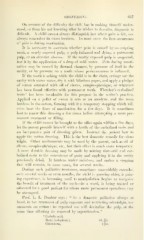Page 669 - My FlipBook
P. 669
ODONTALGIA. 667
On account of the diffieultv the child has in making^ himself under-
stood, or from his not knowing what he wishes to describe, diagnosis is
difficult. A child cannot always distinguish just Avhere pain is felt, nor
always remember its exact location. In most cases the first occurrence
of pain is during mastication.
It is necessary to ascertain whether pain is caused by an erupting
tooth, a nearly exposed pulp, a pulp inflamed and dying, a putrescent
pulp, or an alveolar abscess. If the nearly exposed pulp is suspected,
test it by the application of a drop of cold water. Pain during masti-
oatioii may be caused by thermal changes, by pressure of food in the
€avity, or by pressure on a tooth whose pericementum is inflamed.
If the tooth is aching while the child is in the chair, syringe out the
€avity with warm water, dry it with bibulous paper, and apply a pledget
of cotton saturated with oil of cloves, campho-phenique, or whatever
has been found effective with permanent teeth. Fletcher's carbolized
resin ^ has been invaluable for this purpose in the writer's practice.
Applied on a pellet of cotton it acts as an anodyne, and the resin
hardens in the cotton, forming with it a temporary stopping which will
even bear the force of mastication for a few days. It is sometimes
best to renew this dressing a few times before attempting a more per-
manent treatment or filling.
If the child cannot be brought to the office again within a few days,
let the parent provide himself with a bottle of the carbolized resin and
an inexpensive pair of dressing pliers. Instruct the patient how to
apply the cotton dressing. This is the best domestic remedy for odon-
talgia. Other medicaments may be used by the parent, such as oil of
cloves, campho-phenique, etc., but their effect is much more temporary.
A more durable dressing may be made by mixing zinc oxid and car-
bolized resin to the consistence of putty and applying it in the cavity
previously dried. It hardens under moisture, and makes a stopping
that will remain, in some cases, for several weeks.
During such palliative treatment, sometimes unavoidably extended
over several weeks or even months, the child is growino- older, is p-ain-
ing experience, is becoming used to manipulation, begins to recognize
the benefit of treatment of the teeth—in a word, is being trained or
educated for a good patient for whom more permanent operations may
be attempted.
Prof. I>. L. Dunbar savs " As a domestic palliative always at
:
hand, in the treatment of pulp exposure and restricting odontalgia, use
ammonia on cotton : its repeated use will devitalize the pulp, at the
same time effecting its removal by saponification."
^ Carbolic acid,
Resin (colophony), da. 5J
;
Chloroforna, i.^ss.


